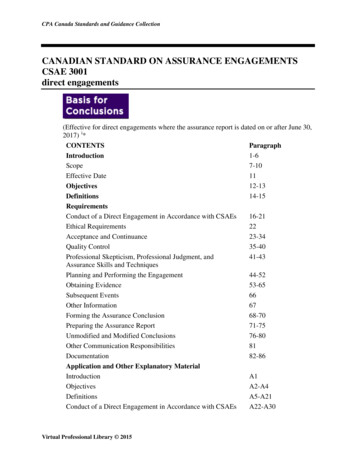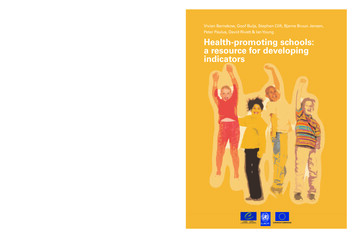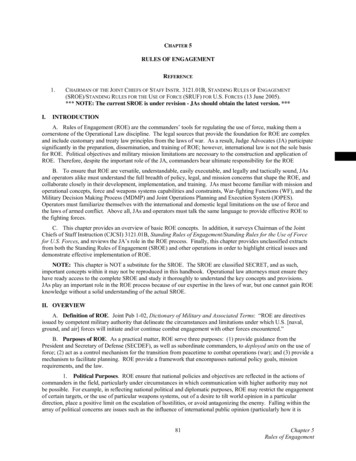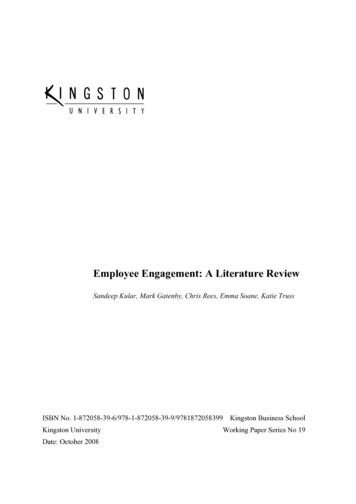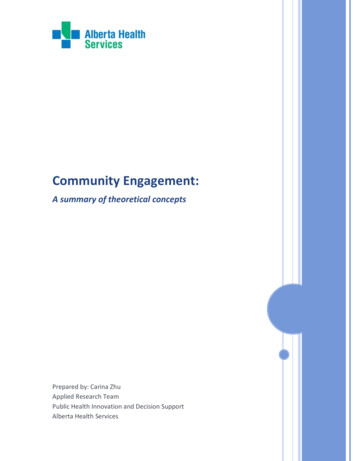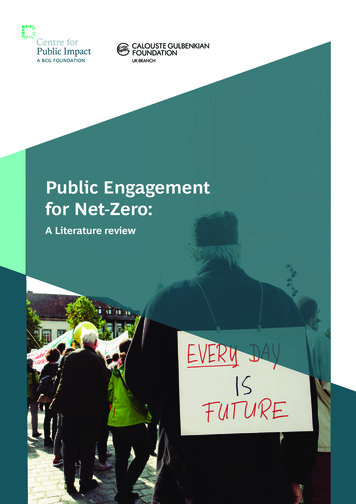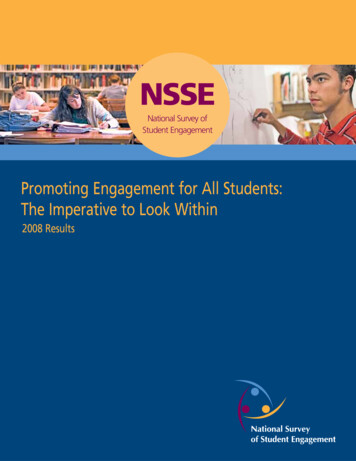
Transcription
NSSENational Survey ofStudent EngagementPromoting Engagement for All Students:The Imperative to Look Within2008 Results
Table of ContentsNational Advisory BoardDouglas Bennett, ChairCharlie NelmsPresident, Earlham CollegeChancellor, North Carolina Central UniversityMolly Corbett BroadPatrick TerenziniPresident, American Council on EducationDistinguished Professor and Senior Scientist,Center for the Study of Higher Education,The Pennsylvania State UniversityForeword . 3Director’s Message. 6Rebecca S. ChoppPresident, Colgate UniversityJudith Torney-PurtaPeter EwellVice President, National Center for HigherEducation Management Systems (NCHEMS)Professor of Human Development,University of MarylandWilliam TysonQuick Facts . 9Selected Results .11Looking Within. 12Promoting Success in the First Year . 17FSSE-BCSSE . 20Writing Matters . 21President, Morrison and Tyson CommunicationsMuriel A. HowardUsing NSSE Data . 23President, Buffalo State CollegeEx officioPat HutchingsVice President, The Carnegie Foundationfor the Advancement of TeachingStanley IkenberryRegent Professor and President Emeritus,University of Illinois Urbana-ChampaignJohn KennedyNSSE Institute for Effective Educational Practice . 27Director, Center for Survey Research,Indiana University BloomingtonLooking Ahead. 29Kay McClenneyReferences and Resources . 30Director, Community College Survey of Student EngagementJohn ImmerwahrAssociate Vice President for Academic Affairs,Villanova UniversityBenchmarks of Effective Educational Practice . 31Participating Colleges and Universities: 2000–2008 . 43NSSE Staff . 50“One of the best aspects of my educationexperience thus far has been seeing howdifferent subjects of study have so much incommon. I am seeing common themes ina diverse range of classes, and I love that myeducational experience here will be such anintegral one.”— Senior student, Elizabethtown CollegeCover ImagesFront CoverLeft–College of CharlestonRight–Jacksonville UniversityThe National Survey of Student Engagement (NSSE) documentsdimensions of quality in undergraduate education and providesinformation and assistance to colleges, universities, and otherorganizations to improve student learning. Its primary activityis annually surveying college students to assess the extent towhich they engage in educational practices associated withhigh levels of learning and development.Delaware Valley CollegeBack CoverLeft–Austin CollegeCenter–Georgia Institute of TechnologyRight–University of Michigan
ForewordThe Power of a Big IdeaLike the speaker who “needs no introduction,” NSSE may wellhave achieved an eminence that requires no foreword. Theacronym is everywhere: on institutional Web sites and the lipsof parents and students selecting a college; the pages of USATODAY, the Chronicle of Higher Education, Change magazine,and The New York Times; the 2006 report from the NationalCommission on the Future of Higher Education, and now onthe template for the Voluntary System of Accountability beingdeveloped by several education associations. In fact, go to Googleand you’ll find “about 299,000” entries that deal with NSSE.Reading back over reports from the past decade, as I didwhen invited to write this piece, is downright dizzying. In1998, the idea of a tool that would provide a new lens on theundergraduate experience was a gleam in the eye of a planninggroup convened by The Pew Charitable Trusts. By 2000, aftera smaller pilot-study year, 276 campuses had signed on. Sincethen, the original instrument has not only been refined andsupplemented, it has spawned a substantial family tree: theCommunity College Survey of Student Engagement, anotherfocused on law students, a newer one examining the experienceof beginning college students, and—my favorite for reasons thatwill be clear below—a survey of faculty.In addition, an incredibly hard-working staff has produced twomajor volumes based on NSSE use and data, made scores ofpresentations, consulted with hundreds of campuses, and writtena long list of research and psychometric studies. As reportedin the pages that follow, 769 institutions participated in 2008,Alma College3 National Survey of Student Engagement 2008 Resultsbringing the total to more than 1,300 colleges and universitiessince NSSE’s inception. In short, in an enterprise—I mean highereducation—famous for its molasses-like pace in adopting newways, NSSE is an amazing success story.of a larger commitment to improvement driven by evidenceand understanding.In both higher education and K 12 settings, the view thatevidence should guide reform is, in fact, commonplace today.But reform turns out not to be so easy. Even the best information (begging the question of what “best” looks like) does notcreate change all by itself. Data from studies of how peoplelearn may feel too far afield and too general to catalyze localaction. Institution-level data, though closer to home, may noteasily connect with what faculty care about in their departmentsor programs or with the methods and questions valued by theirfield. And at the same time, faculty exploring their own students’learning in their own classrooms may lack the sense of largercontext (such as: what happens to those students when they moveto the next course in the sequence) needed to make meaningof what they’re seeing and to think about what might be donedifferently or better.Stepping back from this rush of activity and development, it’sworth remembering that NSSE is also a story about the powerof a big idea to change the way we think and talk, to alterour expectations and our practices. To put this in a personalcontext, I sometimes find myself reflecting back on my ownundergraduate years several decades ago. They were great.The teachers were eloquent and often charismatic; my fellowstudents were smart and stimulating. I loved my courses, I lovedthe campus, I practically lived in the library, and, well, I think Iturned out alright. But the questions on NSSE would have beenfrom Mars for me. I was never asked to write multiple draftsof a paper, to do a collaborative research project, make a classpresentation, connect themes from one course with what I waslearning in another, engage in service-learning or undergraduateStepping back from this rush of activityand development, it’s worth rememberingthat NSSE is also a story about the powerof a big idea to change the way we thinkand talk, to alter our expectations andour practices.research. experiences that are, increasingly (though still notsufficiently) part of the landscape of undergraduate educationon many campuses. Of course this sea change has many sources,and many people, projects, movements, and organizations havecontributed to it. But NSSE has made a special contribution bytaking the general concept of student engagement and giving itlegs and language. Oh, yes, and scores.Students aren’t the only ones who benefit from engagement. IfNSSE is to be a vehicle for improvement—not just a source ofalternative data—institutions of higher education, and especiallyfaculty (by which I mean the full range of professionals involvedin instruction, including student affairs staff and librarians aswell as discipline-based faculty) need to be engaged. In fact, it’sintriguing to think about how the NSSE benchmarks—AcademicChallenge, Active and Collaborative Learning, Student-FacultyInteraction, Enriching Educational Experiences, and SupportiveCampus Environment—might apply not only to students butto faculty and institutions. For instance, an engaged campus(or department or program) would be one in which everyoneembraces the challenge of continually doing better for students.Radford UniversityAn engaged campus is one in which people actively collaborate tounderstand more about the student experience and work togetherto design better approaches and programs. It’s one where facultyseek out student perspectives on their own learning, and see themas critical voices in the ongoing conversation about quality.Summing up, engagement means creating habits of mind. Itrequires a campus environment in which educators are activelyinvolved in asking questions about the experience of theirstudents, talking together about the impact of that experience onwhat students know and can do, demanding more of themselvesand their students, digging deeper, trying new approaches, askingwhy and how, and always learning from their own experience aseducators.Happily, this kind of engagement among educators is on therise. In the circles I run in, it often comes flying the flag ofthe scholarship of teaching and learning. Faculty from a widerange of disciplines and fields in all kinds of institutions arenow treating their classrooms as sites for inquiry, consulting thepedagogical literature, systematically exploring their students’learning, and doing so in ways that not only improve their ownclassrooms, but can inform the work of colleagues as well. In thiscontext, one might see NSSE as an instance of the scholarship ofteaching and learning beyond the level of the classroom—partAnd here is where NSSE can be so helpful—in filling out whatI’ll call “the missing middle” between general, aggregate data andfindings and particular classroom-based evidence and insights.Especially when catalyzed by the use of the Faculty Survey ofStudent Engagement—which brings into view in a very concrete,immediate way the extent to which faculty promote the activitiesthrough which students can be effectively engaged. NSSE findingsAnd here is where NSSE can be so helpful—in filling out what I’ll call “the missingmiddle” between general, aggregate dataand findings and particular classroombased evidence and insights.are grist for educators to come together around issues andopportunities at the often missing but powerful middle level ofthe program, department, or cluster of courses (like learningcommunities). Indeed, this year’s annual NSSE report focuses onquestions about variations in the kind and degree of engagementacross the campus that are perfect prompts for this kind ofdeliberation and initiative.Again, gathering data is not enough to make this happen.Campuses must create occasions where people can (yes) engagewith the data and with one another, and ask what this or thatnew finding tells them about what to do in their own setting,how the first-year experience can be strengthened, whether itmakes sense to add further service-learning opportunities, andso forth. The beauty of NSSE is that it provides a window intoNational Survey of Student Engagement 2008 Results 4
Foreword (continued)Director’s Messagelocal practice in ways that people can act on together to makea larger difference.In this spirit, I’d like to argue for a special opportunity whereNSSE and the scholarship of teaching and learning cometogether. During the past decade the Carnegie Academy for theScholarship of Teaching and Learning (CASTL) has involvedmore than 200 campuses; a good number of those overlap withthe NSSE-user universe. But it’s not at all clear that the twoThe beauty of NSSE is that it provides awindow into local practice in ways thatpeople can act on together to make alarger difference.conversations have found one another. Thus, I like to imaginewhat might happen when individuals studying their ownclassrooms are invited to join others who are looking at largerpatterns in the student experience as captured through NSSEand its family of instruments. And, of course, their deliberationsare likely to be even better if informed by work going on in the“There is often a gap between how much collegefaculty think students are studying and whatthey are actually doing. NSSE combined withFSSE points to steps institutions can take toensure that student performance and facultyexpectations align.”— Carol A. Twigg, President and CEO, National Center forAcademic Transformationgrowing “teaching commons” of educators sharing and buildingknowledge with a whole range of tools and methods. Indeed,this is precisely what higher education needs: more people usinga wider range of good tools and methods to understand moredeeply how to help all learners learn.This point was prefigured in the foreword to NSSE’s first fullannual report in 2000 by Lee S. Shulman, then president of TheCarnegie Foundation for the Advancement of Teaching, andRuss Edgerton, then director of education programs at The PewCharitable Trusts. Describing a lake at the center of the campusat Beijing University, they say, “To see [the whole lake], one mustmove from one vantage point to another, looking carefully, takingnote, and moving on. So it is with what universities teach, learn,and investigate: those matters worth knowing well are rarelyunderstandable from a single perspective.” NSSE, as they pointout, is a huge step forward in providing a new perspective, and Iwould add that it’s all the better because the supply of tools forachieving different perspectives is quickly growing.As many readers will know, Lee Shulman recently retired fromCarnegie, and the Foundation has a new president, Anthony S.Bryk. Under his leadership, Carnegie will continue to be a cosponsor of NSSE and a vigorous advocate for the big idea behindit. If anything, our enthusiasm for the enterprise has deepenedover the years, a fact made evident in our ultimate sacrifice thislast year: saying good-bye to long-time Carnegie senior scholar,Alex McCormick, as he went off to assume the directorship ofNSSE. We wish him and his staff and the many users of NSSEall the best and look forward to learning from the many levelsof engagement their work makes possible.Pat HutchingsVice PresidentThe Carnegie Foundation for the Advancement of TeachingHamline University5 National Survey of Student Engagement 2008 ResultsToward a Nuanced View of Institutional QualityI vividly recall my introduction to NSSE. It was 1999. GeorgeKuh was visiting The Carnegie Foundation for the Advancementof Teaching to present tantalizing findings from NSSE’s pilotstudy involving some 13 institutions. All of us around thetable felt great enthusiasm for a project that showed suchpromise for advancing the assessment and improvement ofundergraduate education, while also refocusing the discussionof college quality squarely on teaching and learning (and awayfrom reputation, resources, and the characteristics of enteringstudents). Enthusiasm and promise notwithstanding, in thoseearly days there were serious doubts as to whether NSSE wouldcatch on and prove sustainable. In retrospect, it’s hard to believethere could ever have been any doubt. From today’s vantagepoint NSSE is a remarkable success story, with more than 1,300institutions having participated since 2000. That success reflectsin equal measure the tireless efforts of Kuh and the NSSE staff,the wise counsel of the National Advisory Board, as well asgenuine commitment to evidence-based improvement on thepart of many hundreds of institutional personnel—presidents,provosts, deans, faculty members, institutional researchers,student affairs staff, admissions staff, and others.Texas A&M University–Corpus ChristiIn both my previous and present work, I have frequently beenreminded of the strong tendency in higher education to focusattention at the institutional level and to make comparisonsbetween institutions. But we need to remember the complexity ofour institutions and of the individuals who make them up, and inso doing we must resist reductionism. We must look within.The Imperative to Look WithinU.S. higher education is marked by a pronounced diversity ofinstitutional types, missions, programs, and student populations.Reflecting this diversity, viewbooks, Web sites, admissionletters, and convocation addresses frequently call attention toand dramatize institutional distinctiveness. Thus it is perhapsnot surprising that we tend to think of educational qualityas an institutional attribute, and of one college as offering auniformly better or worse education than another. This is ofcourse reinforced by national rankings of “best colleges” andtheir illusory precision: if one school stands at number 70 amongnational universities, for example, we are tempted to believe thatall who attend will enjoy a superior education to those attendingnumber 71, 75, 80, or 100. The current policy discourse aboutaccountability and transparency, with calls for standard measuresof institutional performance and tools to facilitate comparisons,comports with and encourages the conception of quality as auniform institutional attribute.Though it may be appealing, both research and individualexperience belie this notion of uniform quality. A robust findingfrom decades of research on college students holds that studentexperiences and outcomes are more varied among students withininstitutions than among institutions. The statistical explanationis a bit complex, but almost anyone who attended college hasfirst-hand experience that bears this out. Ask a college graduate ifshe experienced the same level of quality throughout her collegecareer—between departments, between instructors, or from oneweek, month, or semester to the next. Ask as well whether allof her peers experienced the institution the same way that shedid, with respect to quality of undergraduate education, sense ofsupport or belonging, and so on. Without hesitation, most if notall will report that quality was variable. This is the experientialanalogue of the generalized research finding: college quality is notuniform within institutions—it’s uneven and variable. It’s lumpy.The point is not that measuring institutional performance ispointless or that institutional comparisons are meaningless, butthat we must take care about the inferences we draw from theobserved differences. To be sure, some institutions outperformothers with respect to various aggregate quality measures—including the NSSE benchmarks—and differences in institutionalaverages are meaningful. The inferential mistake is to assume thatthe differences observed between (hypothetical) average studentsapply to all students.In the pages that follow, we illustrate this phenomenon usingNSSE’s five Benchmarks of Effective Educational Practice.National Survey of Student Engagement 2008 Results 6
Director’s Message (continued)questions about how writing is taught and how studentsapproach the task of writing, and we asked these questions ofa subset of NSSE respondents. As reported in detail in SelectedResults, the findings reveal both the widespread use of a numberof best practices in the teaching of writing, as well as severalareas where there is room for improvement. We also documentsystematic relationships between good practices in writinginstruction and NSSE measures of deep learning. These areimportant findings that can be used to improve the developmentof written expression on all campuses.We show that for almost all of the benchmarks, less than 10percent of the total variation in effective educational practicesis attributable to institutions. The lion’s share of the variationis among students, within institutions. What this means is thatrestricting attention to the institutional differences overlooksmost of the variation, and amounts to studying the tip of theiceberg. In urging NSSE users and other readers of this report to“look within,” we call attention to the rest of the iceberg.What does it mean to look at the restof the iceberg? It means examiningvariation in the student experiencewithin an institution.What does it mean to look at the rest of the iceberg? It meansexamining variation in the student experience within aninstitution. How do experiences differ by major or by groups ofrelated majors? By demographic or enrollment subgroups? Orto look at it another way, who are the least engaged students(for example, the bottom quarter of the distribution within aninstitution), and what can be done to improve their experienceso as to narrow the gap between an institution’s least and mostengaged students?Another implication of looking within is that even highperforming institutions as identified by average benchmark scoreshave work to do to improve the experience of all students. Thispoint is clearly illustrated by examining the bottom quartilebenchmark scores for students at institutions that NSSE hasidentified as “Top 10%” performers based on institutionalaverages. With only one exception, the 25th percentilebenchmark score (that is, the highest score among students in thebottom quarter) at these top performing institutions matches ortrails the median for all students in NSSE 2008 (see Table 1).about future directions are beginning to take shape. More on thisin the Looking Ahead section of this report.NSSE is a powerful and increasingly important tool for assessingand improving the quality of undergraduate education andenriching the national discourse about college quality. As weenter our second decade of this important work, I welcomesuggestions and feedback from NSSE veterans as well as novices.Alexander C. McCormickDirector, National Survey of Student EngagementAssociate Professor, Indiana University School of EducationConcluding ThoughtsNorthern Arizona UniversityPromoting Success in the First Year of CollegeAnother important aspect of looking within involves carefulanalysis of entering students to identify those who mayneed special intervention to ensure engagement and success.Information from the Beginning College Survey of StudentEngagement (BCSSE), which is typically administered to enteringstudents before classes begin, can be used to assess students’propensity for engagement in college with an eye to earlyidentification of those who may be at risk for low engagement.Similarly, previous findings of compensatory effects ofengagement for underprepared students mean that special effortsshould be made to promote educationally effective activitiesfor this population. Illustrations of these analyses appear in theSelected Results section.As I write this message, nearly nine months have passed since Isucceeded George Kuh as NSSE’s director. Assuming leadershipof a successful project is a mixed blessing. On the plus side,the really hard work has already been done: systems have beendeveloped to ensure the smooth operation of a very complexenterprise, a capable and dedicated staff is in place, the qualityof our work is well-established, and we have a solid base ofcommitted users as well as a steady stream of newcomers. Onthe other side, I face the challenge of sustaining our record ofinnovation, advancing our work without sacrificing our corestrengths. Mindful of the adage “if it ain’t broke, don’t fix it,” Iam spending much of my first year observing how we do whatwe do and learning from the NSSE staff. That said, some ideasLooking within also involves focusing attention on particulardomains of teaching and learning. Developing students’ writingability is a goal shared by virtually all colleges and universities.A collaboration between NSSE and The Council of WritingProgram Administrators resulted in a set of supplemental— Senior student, Buffalo State College (SUNY)Table 1: Bottom Quartile Benchmark Scores for Students at Top-PerformingInstitutions Compared with Median Scores for All NSSE 2008a StudentsBenchmarkWriting Matters“I think one of the most important aspects ofBuffalo State College is that I was a personto so many people, not a number. Being afriend, a colleague, a tutor, a confidant, a teammember, etc., helped me become an individualand get to know myself and grow as an adult.Having a name is key to having a willingnessand ambition to learn.”Bottom Quartile atTop 10% InstitutionsNSSE 2008 MedianLevel of Academic ChallengeFirst-Year52 53Senior54 57First-Year38 42Senior48 48First-Year28 33Senior39 39First-Year23 26Senior43 40First-Year56 61Senior56 58Active and Collaborative LearningStudent-Faculty Interaction“Using NSSE and FSSE can be an importantelement in developing strategies to help allstudents achieve learning outcomes essential forthem to address the challenges of a 21st century,globally interdependent world.”Enriching Educational ExperiencesSupportive Campus Environment— Alma R. Clayton-Pedersen, Vice President, Office ofEducation and Institutional Renewal, Association ofAmerican Colleges and UniversitiesAlbright College7 National Survey of Student Engagement 2008 ResultsaLimited to U.S. NSSE institutionsNational Survey of Student Engagement 2008 Results 8
Quick FactsSurveyAudiencesThe NSSE survey is available in paper and Web versions andtakes about 15 minutes to complete. To view the survey, go to:www.nsse.iub.edu/html/survey instruments 2008.cfm.College and university administrators, faculty members,advisors, student life staff, students, governing boards,institutional researchers, higher education scholars, accreditors,government agencies, prospective students and their families,high school counselors, and journalists.ObjectivesProvide data to colleges and universities to assess and improveundergraduate education, inform state accountability andaccreditation efforts, and facilitate national and sectorbenchmarking efforts, among others.PartnersEstablished in 2000 with a grant from The Pew Charitable Trustsand sponsored by The Carnegie Foundation for the Advancementof Teaching. Support for research and development projects fromLumina Foundation for Education, the Center of Inquiry in theLiberal Arts at Wabash College, Teagle Foundation, and theNational Postsecondary Education Cooperative.Figure 1: NSSE 2008 Participating Colleges and UniversitiesParticipating Colleges and UniversitiesSince its launch in 2000, more than 1,300 four-year collegesand universities have participated in NSSE, with 769 in2008. Participating institutions generally mirror the nationaldistribution of the 2005 Basic Carnegie Classification (Figure 1).Participation AgreementParticipating colleges and universities agree that NSSE willuse the data in the aggregate for national and sector reportingpurposes and other undergraduate improvement initiatives.Colleges and universities can use their own data for institutionalpurposes. Results specific to each college or university andidentified as such will not be made public except by mutualagreement.30%NSSE 2008National25%AdministrationIndiana University Center for Postsecondary Research incooperation with the Indiana University Center for SurveyResearch.20%15%Data Sources10%5%0%RU/VHRU/HDRUMaster’s L Master’s M Master’s S Bac/A&S Bac/DivCarnegie 2005 Basic ClassificationsRU/VHResearch Universities (very high research activity)RU/HResearch Universities (high research activity)DRUDoctoral/Research UniversitiesMaster’s LMaster’s Colleges and Universities (larger programs)Master’s MMaster’s Colleges and Universities (medium programs)Master’s SMaster’s Colleges and Universities (smaller programs)Bac/A&SBaccalaureate Colleges–Arts & SciencesBac/DivBaccalaureate Colleges–Diverse FieldsPercentages are based on U.S. institutions that belong to one of theeight Carnegie classifications above.www.carnegiefoundation.org/classifications/9 National Survey of Student Engagement 2008 ResultsRandomly selected first-year and senior students from hundredsof baccalaureate-granting institutions. Supplemented by otherinformation such as institutional records, results from othersurveys, and data from the Integrated Postsecondary EducationData System (IPEDS).Validity & ReliabilityThe NSSE survey was designed by experts and extensively testedto ensure validity and reliability and to minimize nonresponsebias and mode effects. For more information visit the NSSE Website at www.nsse.iub.edu/2008 Institutional Report/index.cfm.Response RatesIn 2008, the average institutional response rate was 37%.The average for Web-only institutions (39%) exceeded that ofinstitutions that used the paper administration mode (32%).Consortia & State or University Systems2000–2008American Association of State Colleges & UniversitiesAmerican Democracy ProjectArts ConsortiumAssociated New American CollegesAssociation of American Universities Data ExchangeAssociation of Independent Colleges of Art and DesignAssociation of Independent Technical UniversitiesBringing Theory to PracticeCalifornia State UniversityCanadian ConsortiumCanadian Research UniversitiesCatholic Colleges & UniversitiesCity University of New YorkColleges That Change LivesCommittee on Institutional CooperationConcordia UniversitiesConnecticut State UniversitiesCouncil for Christian Colleges & UniversitiesCouncil of Independent CollegesCouncil of Public Liberal Arts CollegesFlashlight GroupHispanic Serving InstitutionsHistorically Black Colleges and UniversitiesIndiana UniversityInformation Literacy ConsortiumJesuit Colleges and UniversitiesKentucky Council on Postsecondary EducationLutheran Colleges and UniversitiesMid-Atlantic Private CollegesMilitary Academy ConsortiumMission Engagement Consortium for Independent CollegesNew Jersey Public UniversitiesNorth Dakota University SystemOnline Educators ConsortiumOntario UniversitiesPenn State University SystemPennsylvania State System of Higher EducationPrivate Liberal Arts Colleges and UniversitiesSouth Dakota Public UniversitiesState University of N
it requires a campus environment in which educators are actively involved in asking questions about the experience of their students, talking together about the impact of that experience on what students know and can do, demanding more of themselves and their students, digging deeper, trying new approaches, asking why and how, and always learning

